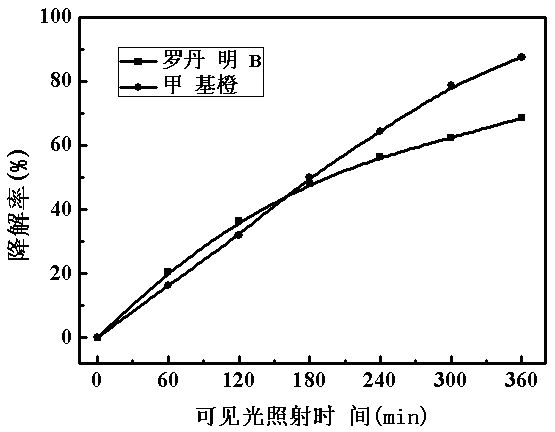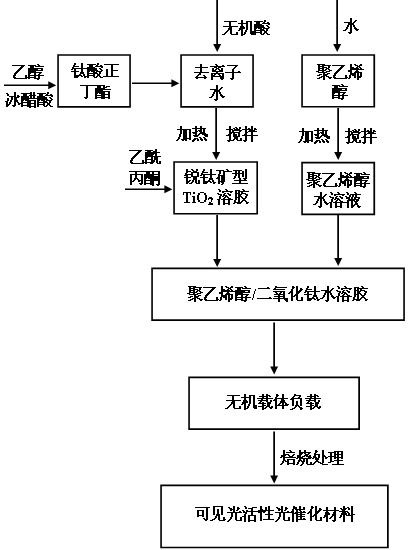Supported photocatalyst with high activity under visible light and preparation method thereof
A photocatalytic material, visible light technology, applied in catalyst activation/preparation, chemical instruments and methods, physical/chemical process catalysts, etc., can solve the problems of low catalytic activity, difficult loading, etc., achieve simple preparation process, widen light response range, the effect of good photocatalytic activity
- Summary
- Abstract
- Description
- Claims
- Application Information
AI Technical Summary
Problems solved by technology
Method used
Image
Examples
Embodiment 1
[0022] First, add 0.1 parts of concentrated hydrochloric acid and 100 parts of distilled water into a reaction kettle equipped with a thermometer, a stirrer and a reflux condenser, raise the temperature to 70°C, add 5 parts of n-butyl titanate, 15 parts of absolute ethanol and 10 parts of The mixed solution of glacial acetic acid was reacted for 0.5h to obtain a translucent sol, which was further aged at room temperature for a certain period of time to obtain a bluish transparent TiO 2 Sol; take 20 parts of TiO 2 sol, add 0.5 part of acetylacetone, after stirring evenly, add 0.1 part of 15% PVA (polymerization degree 500, alcoholysis degree 99%) solution, continue stirring for 1 hour to get PVA / TiO 2 Sol; the PVA / TiO 2 The sol is coated on the inorganic carrier, dried at 70°C, and finally the carrier loaded with the catalyst is placed in a muffle furnace protected by an inert gas, heated to 300°C, and calcined for 1 hour to obtain the composite photocatalytic material.
Embodiment 2
[0024] First, add 0.5 parts of concentrated nitric acid and 150 parts of distilled water into a reaction kettle equipped with a thermometer, agitator and reflux condenser, raise the temperature to 50°C, add 10 parts of n-butyl titanate, 20 parts of absolute ethanol and 1 part of A mixed solution of glacial acetic acid was reacted for 2 hours to obtain a translucent sol, which was further aged at room temperature for a certain period of time to obtain a bluish transparent TiO 2 Sol; take 20 parts of TiO 2 Sol, add 1.0 parts of acetylacetone, after stirring evenly, add 5 parts of 5% PVA (polymerization degree 1700, alcoholysis degree 88%) solution, continue to stir for 2 hours to get PVA / TiO 2 Sol; the PVA / TiO 2 The sol is coated on the inorganic carrier, dried at 80°C, and finally the carrier loaded with the catalyst is placed in a muffle furnace protected by an inert gas, heated to 120°C, and calcined for 3 hours to obtain the composite photocatalytic material.
Embodiment 3
[0026] First, add 1 part of concentrated hydrochloric acid and 50 parts of distilled water into a reaction kettle with a thermometer, a stirrer and a reflux condenser, raise the temperature to 60°C, add 15 parts of n-butyl titanate, 5 parts of absolute ethanol and 5 parts of A mixed solution of glacial acetic acid was reacted for 5 hours to obtain a translucent sol, which was further aged at room temperature for a certain period of time to obtain a bluish transparent TiO 2 Sol; take 20 parts of TiO 2 Sol, add 0.05 parts of acetylacetone, after stirring evenly, add 20 parts of 1% PVA (polymerization degree 2400, alcoholysis degree 78%) solution, continue stirring for 1 hour to get PVA / TiO 2 Sol; the PVA / TiO 2 The sol is coated on the inorganic carrier, dried at 60°C, and finally the carrier loaded with the catalyst is placed in a muffle furnace protected by an inert gas, heated to 200°C, and calcined for 6 hours to obtain the composite photocatalytic material.
PUM
| Property | Measurement | Unit |
|---|---|---|
| degree of polymerization | aaaaa | aaaaa |
| alcoholysis degree | aaaaa | aaaaa |
Abstract
Description
Claims
Application Information
 Login to View More
Login to View More - R&D
- Intellectual Property
- Life Sciences
- Materials
- Tech Scout
- Unparalleled Data Quality
- Higher Quality Content
- 60% Fewer Hallucinations
Browse by: Latest US Patents, China's latest patents, Technical Efficacy Thesaurus, Application Domain, Technology Topic, Popular Technical Reports.
© 2025 PatSnap. All rights reserved.Legal|Privacy policy|Modern Slavery Act Transparency Statement|Sitemap|About US| Contact US: help@patsnap.com



